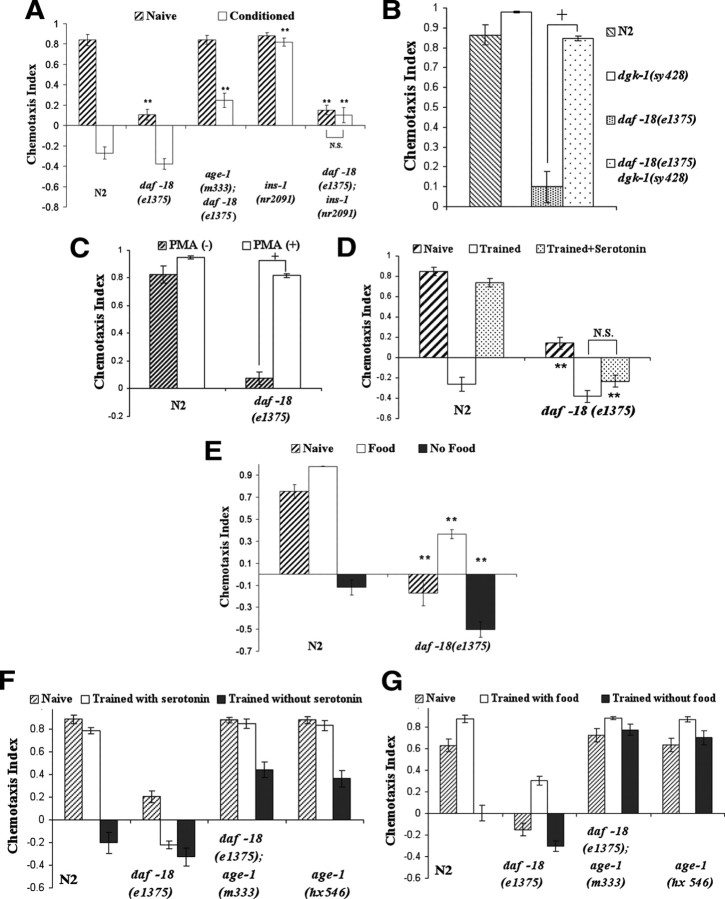Figure 3.
daf-18 animals exhibit abnormal odorant chemotaxis and odorant associative plasticity. For all panels in the figure, double asterisks represent significant differences from N2 within the same group (**p < 0.05 by Bonferroni's t test). Crosses represent significant differences between the indicated data points (+p < 0.05 by Bonferroni's t test). N.S., Not significant. Data represent means ± SEM. A, Benzaldehyde–starvation associative plasticity in animals with the daf-18 mutation. daf-18 mutants demonstrated an attenuated naive benzaldehyde attraction but normal benzaldehyde–starvation associative plasticity. The abnormal benzaldehyde chemotaxis could be suppressed by the age-1 mutation, while the normal associative plasticity could be blocked by the ins-1 mutation in daf-18 mutants. A two-way ANOVA revealed a significant interaction between strain and conditioning, F(4,59) = 32.06, p < 0.05 (n = 6 plates for each data point). B, Chemotaxis of dgk-1 and daf-18; dgk-1 mutants to 1% benzaldehyde. The dgk-1 mutation fully reversed the attenuated naive benzaldehyde attraction in daf-18 mutants. A Kruskal-Wallis one-way ANOVA revealed significance in groups, H = 19.7, p < 0.05 (n = 6 plates for each data point). C, Naive benzaldehyde chemotaxis of N2 and daf-18 animals after 2 h of PMA treatment. Treating daf-18 animals with PMA significantly reversed their decreased benzaldehyde chemotaxis. A two-way ANOVA revealed a significant interaction between strain and PMA treatment, F(1,19) = 63.236, p < 0.05 (n = 5 plates for each data point). D, Benzaldehyde–starvation associative plasticity in animals conditioned in the presence of serotonin. Serotonin treatment during conditioning did not significantly alter benzaldehyde–starvation associative plasticity in daf-18 mutants. A two-way ANOVA revealed a significant interaction between strain and conditioning, F(2,35) = 31.86, p < 0.05 (n = 6 plates for each data point). E, Butanone–starvation associative plasticity and butanone–food associative plasticity in daf-18 mutants. daf-18 mutants exhibited naive butanone avoidance, enhanced butanone–starvation associative plasticity, and impaired butanone–food associative plasticity. A two-way ANOVA revealed a significant interaction between strain and conditioning, F(2,35) = 7.83, p < 0.05 (n = 6 plates for each data point). F, Benzaldehyde–starvation associative plasticity in animals conditioned in the presence of serotonin. Serotonin treatment during conditioning did not significantly alter benzaldehyde–starvation associative plasticity in daf-18 mutants. daf-18; age-1 double mutants showed performance similar to that of age-1 mutants in the assay. A two-way ANOVA revealed a significant interaction between strain and conditioning, F(6,47) = 13.34, p < 0.05 (n = 4 plates for each data point). G, Butanone–starvation associative plasticity and butanone–food associative plasticity in daf-18, daf-18; age-1, and age-1 mutants. daf-18 mutants exhibited naive butanone avoidance, enhanced butanone–starvation associative plasticity, and impaired butanone–food associative plasticity. daf-18; age-1 double mutants showed performance similar to that of age-1 mutants in the assay. A two-way ANOVA revealed a significant interaction between strain and conditioning, F(6,47) = 13.76, p < 0.05 (n = 4 plates for each data point).

